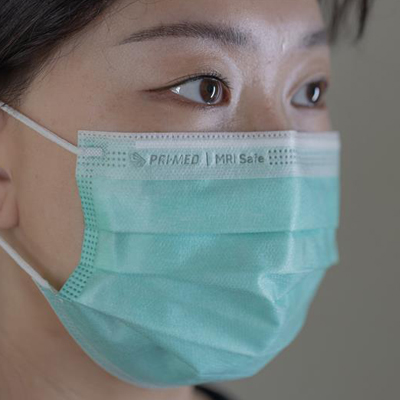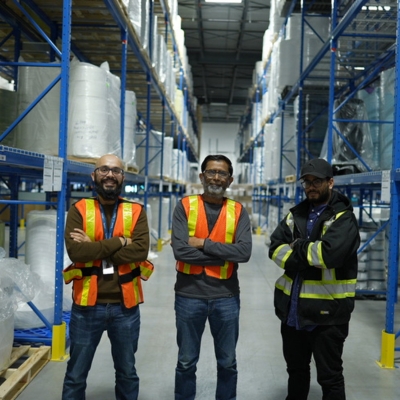PPE use after COVID-19 vaccination

After months of fast-tracked development and global collaboration, the first COVID-19 vaccines are starting to roll out in impressive numbers across the globe.
Vaccines will be critical in winning the fight against COVID-19, but PPE will continue to play an essential role in preventing viral infections for both the general public and healthcare professionals on the pandemic’s frontlines.
In this guide, we’ll look at the reasons to continue using PPE — such as single-use medical masks, medical gloves, and medical gowns — moving forward.
No quick fixes for COVID-19
While there are multiple vaccines currently in production and circulating throughout the world eliminating COVID-19 won’t be a quick victory. Virtually every major medical advisory group continues to recommend social distancing, hand washing, and the use of facial coverings, and this isn’t likely to change soon.
Approved vaccines and research progress should improve peace of mind for the public and healthcare professionals alike. However, these advances shouldn’t be used as reasons to let down our guard.
Between supply constraints, the ability for healthcare facilities and professionals to administer vaccines, and even just the time involved for most currently-approved vaccines to reach full effectiveness, we’re looking at a process that will take time according to Health Canada. In the meantime, there are still answers we don’t have.
Does the vaccine protect against spread?
One of the most important questions is whether vaccinated individuals can still transmit the virus to others. This is simply impossible to ascertain until a certain level of the public has received the vaccination. As herd immunity builds, vaccinated people’s ability to spread COVID-19 to the non-vaccinated should become more apparent.
Does the vaccine protect against COVID-19 variants?
Viral mutations are common.
So the fact that COVID-19 variants continue to pop up around the globe shouldn’t immediately cause panic.
However, it is crucial to assess whether any of these new variants will impact current vaccines’ effectiveness.
This is particularly true in healthcare environments where it is more likely that you might come into contact with contagious individuals or early variants before they are widely investigated.
Continuing to wear a mask, following thorough hand washing protocols, and minimizing environmental contamination through the use of shoe coverings, medical gowns, hair coverings, and other PPE will remain a central element of protection from yet-to-be-discovered viral variants regardless of vaccine efficacy.
How long does immunity last?
As reported by the World Health Organization in their analysis of the Moderna vaccine, we still don’t know how long immunity will last with some of these vaccines. Some vaccines — such as those used for the flu — require annual administration. This is due to differences in the virus from year to year and the expected immune system response.
Others, such as MMR or Chicken Pox vaccines, only require a series of vaccines and remain effective for most of a person’s life. Until we know how the COVID vaccine will continue to provide immunity, PPE offers a reliable, dependable level of risk reduction which we can quantify and rely upon.
PPE as a complement to COVID-19 vaccines
For medical professionals, high quality PPE has been an essential part of work routines for decades, but much of the public is new to wearing face masks on a daily basis as recommended by Health Canada.
This has led many to question when we will be able to finally take off our masks and go about life as usual. While running errands or spending extended work periods in a mask might not be ideal, it’s essential to understand that no vaccine is 100% effective. Most rely on a level of herd immunity or infection scarcity to help minimize the impact of those remaining few percentage points of risk.
Suppose the chances of encountering an infected individual are rare. In that case, there’s a good chance that 90-95% effectiveness (roughly the effective rate of current COVID-19 vaccine options) is enough to protect individuals and prevent extended outbreaks and viral spread. But when communities report increased cases or you’re working in a high-risk environment, that 5 to 10% can add up quickly.
For essential workers and healthcare professionals who may have difficulty distancing or frequently interact with large numbers of people, even a small risk margin may create an uncomfortable level of risk. PPE offers an excellent means of shoring up those few percentage points and provides an affordable, effective way of containing spread and minimizing risk.
Also keep in mind that current Moderna and Pfizer-BioNTech vaccines may not achieve immunity until weeks after the initial injection. Maximum effectiveness might require more than one injection.
“One dose of vaccine may not be enough to provide individual protection. You may need to get a second shot to allow your body to develop adequate immunity. We don’t yet know what level of immunity in the population is sufficient to achieve community immunity,” says Health Canada. “Until that time, Canadians should continue to wash their hands, stay home when sick, maintain physical distancing, wear a face mask as appropriate, and keep using good cough and surface hygiene.”
This means that while immunity builds, you could still be at risk of contracting the virus. Supply shortages and panicked buyers made obtaining items difficult in the early days of the pandemic. Today, it’s easy to find masks, gloves, and other PPE. Even medical-rated PPE, such as gloves and single-use masks, are far more accessible to the average person today than vaccinations. They’re something you can purchase and effectively use without the need for professional assistance, in-depth training, medical approvals, or appointments.
Finally, infectious disease has threatened humanity long before the emergence of COVID-19.
Recent examples include:
- The 1918 H1N1 Influenza (Spanish Flu) Pandemic
- The 1968 H3N2 Influenza Pandemic
- The 2002 to 2004 Severe Acute Respiratory Syndrome (SARS) Pandemic
- The 2009 H1N1 Influenza Pandemic
Even once we’ve declared victory against the virus and life has returned to some sense of normalcy, healthcare facilities will continue to follow Infection Prevention and control protocols. Seasonal illnesses, such as influenza, will also continue to impact the public.
Key takeaways
- Several questions remain about vaccines, including vaccinated people’s ability to spread the virus, protection effectiveness against viral variants, and how long the immunity provided by today’s vaccines will last.
- Vaccination efforts will take time as supply chains mature and effective vaccination plans help build overall immunity within the global population. In the meantime, PPE offers an accessible, affordable means of reducing viral spread and reducing infection risk.
- Alongside current vaccines, Health Canada recommends proper mask usage, social distancing, and frequent handwashing remain central tools in controlling the spread of COVID-19 and shoring up protections against infection.
- In healthcare environments, PPE will continue to provide multifaceted and customizable protection against a wide range of infection risks.
As a respected quality leader in PPE, PRIMED has helped to support the frontlines of the COVID pandemic utilizing our wholly-owned supply and manufacturing capabilities to help healthcare providers in Canada and abroad protect those working to protect and serve the health needs of the public. Our comprehensive selection of single-use medical masks, medical gowns, and gloves offer affordable, easy-to-use protection with an emphasis on dependability and comfort. Contact us today to discuss your needs and explore how PRIMED’s industry-leading assortment of products can help your team or facility
References
- Health Canada: Vaccines for COVID-19: Authorized Vaccines
- Government of Canada: What You Need To Know About the COVID-19 Vaccine for Canada
- Reuters UK: Fact Check: Scientists Do Not Yet Know Whether the COVID-19 Vaccine Reduces Transmission of the Virus
- World Health Organization (WHO): How Do Vaccines Work?
- The Conversation: Coronavirus Variants, Viral Mutation and COVID-19 Vaccines: The Science You Need To Understand
- World Health Organization (WHO): The Moderna COVID-19 (mRNA-1273) Vaccine: What You Need To Know
- Healthline: How Long Does Immunity Last After COVID-19? What We Know
- Government of Canada: Coronavirus Disease (COVID-19): Measures To Reduce COVID-19 in Your Community
- STAT: Comparing the Covid-19 vaccines developed by Pfizer, Moderna, and Johnson & Johnson
- The U.S. Centers for Disease Control and Prevention (CDC): 1918 Pandemic (H1N1 Virus)
- The U.S. Centers for Disease Control and Prevention (CDC): 1968 Pandemic (H3N2 Virus)
- History.com: SARS Pandemic: How the Virus Spread Around the World in 2003
- The U.S. Centers for Disease Control and Prevention (CDC): 2009 H1N1 Pandemic (H1N1pdm09 Virus)
- The U.S. Centers for Disease Control and Prevention (CDC): Information about the Moderna COVID-19 Vaccine
- The U.S. Centers for Disease Control and Prevention (CDC): Information about the Pfizer-BioNTech COVID-19 Vaccine
- Hackensack Meridian Health: 3 Reasons Why You Should Continue Wearing a Mask After Getting the COVID-19 Vaccine
- Prevention Magazine: Why You’ll Need to Wear a Mask After Getting the COVID-19 Vaccine, According to Doctors
- Health Magazine: Why Do You Have to Wear a Mask Even After Getting the COVID Vaccine? Here’s What Experts Say
- CTV News: This Is Why You Will Still Need To Wear a Mask After Being Vaccinated
- The Conversation: COVID-19 Vaccine Rollout: Why a Mask and Social Distancing Are Still Needed, Even if You Get the Shot
- The Toronto Star: Yes, the Mask Stays On After You Get Vaccinated. Here’s Why
- Canadian Broadcasting Corporation: Once Someone Is Vaccinated, Do They Still Have To Wear a Mask? Your COVID-19 Vaccine Questions Answered
- The New York Times: Here’s Why Vaccinated People Still Need to Wear a Mask
Related Resources
PRIMED MRI Safe Mask: Safe by Design for Purpose-Built Protection
PRIMED's ASTM Level 3 MRI Safe Masks offer a high-quality, purpose-built solution that merges MRI compatibility with premium protection.

From the Sterile Core to the Decision Table: Elevating the Voice of MDR Professionals
MDR professionals don’t just process products, they influence how they are designed, selected, and standardized.
%20-%20Sterlization%20Wrap%20Display%20(1).jpg)
Protecting with Purpose: The Supply Chain Behind the Mission
PRIMED, resilient through the pandemic, has evolved our supply chain - now stronger, smarter, and ready to meet future challenges with agility and confidence.


